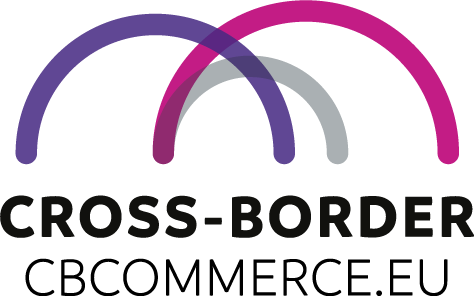Industry Insights Blog
A single point of contact for all shipping issues avoids data chaos
Five steps to improve processes and increase transparency in your cross-border business
Start in your own country and then eventually move to cross-border sales: e-commerce players that want to set themselves up for a strong and successful future need to think outside the box at some point and target new markets for expansion. International e-commerce has gained huge momentum again, not least as a result of the coronavirus pandemic. Latest figures show that 71% of online buyers now also order from foreign stores. In 2020, 293 million people in Europe made cross-border purchases online. However, this boom in online trade not only provides stores and logistics companies with rising sales and wide-ranging options, it also brings increasingly complex, multilayered processes with it that need to be managed. There are more and more predominantly stand-alone business solutions and a huge number of different contacts to deal with that are all responsible for a different market or business area. To ensure that you operate more efficiently and cost-effectively in this context, it is advisable to consolidate your processes and to rely on one point of contact that can pull all the different threads of international shipping together and deal with any questions about carrier management and data analysis.
The following five tips will help you to standardize your international cross-border shipping, reduce your employees’ workload and save costs:
1. Centralize your international shipping processes and contacts
Experts predict that cross-border online retail will soon be worth more than one billion US dollars. According to the Visa Global Merchant E-Commerce study, around 66% of surveyed players in the e-commerce market would like to sell their products abroad in the future. So much for the theory – in practice, there are all kinds of challenges involved in cross-border shipping. Where and how is it best for online stores to start? Which carrier is the right one for which country and which target group? Flexibility and a centralized, strategic approach are required as a solid foundation for successful cross-border shipping. For forward-thinking e-tailers, it is now more important than ever to have an expert partner to rely on when it comes to delivery, etc.; one that can deal with any questions around shipping, carrier management, data analysis, sustainability and insurance. This is the only way to get maximum support for your Europe-wide shipments. Having an experienced contact in this area enables online stores to save a great deal of time and effort, so they can focus on other important tasks. They then do not need to collaborate and make individual arrangements with each carrier or freight forwarder in every country, as would otherwise be the case. Having foreign language skills, such as Dutch, Italian or Spanish, within your own company is also no longer necessary, as the carrier management expert will handle all of the arrangements. There is also no need for the online store to enter into contract negotiations with the individual carriers in each country, as it can benefit from the volumes and rates negotiated by its expert shipping partner. The pooling of parcels from various retailers also reduces prices and protects the environment, as no half-empty trucks are then being sent out onto the roads.
It also means that the logistics team realizes much more quickly if a pallet is lost or unaccounted for or something goes wrong. In case of emergency, it is then only necessary to call one point of contact instead of lots of different people to find out where help is needed. And if it comes to it, thanks to the large network that the delivery partner has available, carriers can be changed quickly. This can take a long time if you have to do it yourself and take up resources that are needed elsewhere. Instead, there is just one number to call for any questions about carriers, tracking, analysis and so on, which saves e-tailers a considerable amount of time and stress.
2. A customized, proactive and targeted customer approach is essential
These days, it is definitely no longer just about getting parcels from A to B quickly, cheaply and without any hitches. E-tailers that want a piece of the more than 4,900 billion strong e-commerce cake need to focus more than ever on providing a personalized customer approach from a single source. This includes providing excellent product quality, services and a top-class online presence. A seamless customer experience in all areas of your approach must also be guaranteed. The shipping and delivery experience play an increasingly important role here and should also be standardized and streamlined. In terms of shipping quality, retailers have much better opportunities to set themselves apart from the competition than some of them realize. The prerequisite for a successful delivery is meeting the individual and varying local customer requirements. To do this, online stores need to understand and be mindful of customer preferences, but also the special geographic features of the particular country. A good example of this is the company BestSecret, an online fashion retailer and subsidiary of Schustermann & Borenstein, which collaborates with the up-and-coming start-up Budbee as well as the national carrier PostNord in Sweden. The aim of this collaboration is to give customers access to additional delivery options and times. In cities like Stockholm, Budbee offers delivery after 6:00 p.m. or a particularly quiet delivery. This means that parents of small children, carers or people working from home, for example, can choose this option when placing their order and ensure that they are not disturbed by the parcel service ringing their doorbell. BestSecret uses Colissimo in France and DHL NL in the Netherlands. It chooses the best carrier to meet the national requirements in the respective country and also makes sure that the customer benefits from an optimal customer experience. As the central delivery partner, Seven Senders consolidates all of the relevant aspects so that the company itself doesn’t have to deal with numerous different advisors and contacts.
3. A carrier network provides extra flexibility and better terms
Having a network of carriers enables online stores to deliver anywhere and to benefit from the various services offered by the different carriers. Customers in every country have their own local preferences in terms of the place and type of delivery or the payment methods. They want to be able to choose when, where and how their parcel is delivered. E-tailers put themselves in the best position to meet international shipping requirements if they develop an extensive network that incorporates the strengths of the individual carriers. Retailers also need to keep up to date with the local carrier situation, as the carrier market is always changing. In terms of the last mile, innovative companies are emerging that are picking up on trends like sustainability, timed delivery or real-time tracking of deliverers, enabling them to offer retailers additional distinguishing features. It is much more environmentally friendly not to send half-empty trucks out onto the roads. In this respect, a carrier network is a good option for online retailers that are expanding into new countries and want to explore new markets, because they often don’t have the shipping volumes needed to negotiate good prices for themselves. Choosing the right shipping partner or the right mix of carriers can be crucial, as it can also bring opportunities for growth and cost savings. Flexibility and easy switching of carriers is also an advantage during peak times and crisis situations, and also as parcel volumes increase. It may be the case that a carrier cannot deliver as planned because hubs need to close. Depending on the restrictions in the country or the carrier’s own restrictions, e-tailers are able to choose an alternative delivery service in order to honor their delivery promise. By having a local carrier, they also benefit from local expertise and can ensure that their international business develops in the best possible way. Last but not least, online stores should ideally also offer various delivery possibilities via different carriers – for example, PUDOs and parcel stores – as these will give them more flexibility and enable them to offer customers different options for reliable delivery, and thus avoid potential disappointment. The perfect delivery depends entirely on choosing the right carrier or the service that they offer. Many local carriers specialize in providing specific services, such as timed delivery, parcel lockers or sustainable delivery by bike or electric vehicle, for example. However, delivery companies often only offer services like these in specific regions. To use these services, shippers need to get their parcels to the local carrier’s hub by the fastest means possible. This involves a lot of logistical effort, as seamless transport has to be planned and service providers coordinated with each other perfectly. A central shipping contact can deal with this important task.
4. Ensure seamless and customer-focused communication
Online retailers need to maintain the best possible contact with end customers at all touchpoints in the customer journey. Shipping and delivery play a key role here, as the punctual delivery of goods is an essential factor for the customer. In a study by Skopos, about 94% of respondents said that the quality of customer service affected brand image, and for 88% it influenced their purchasing decision. According to a YouGov survey carried out on behalf of Seven Senders, the speed of the delivery is an important criterion for choosing an online store for one in four online customers in Europe. Only same-day, next-day or two-day deliveries are still considered to be “fast.” Customers are even prepared to pay more to have faster deliveries. Buyers also expect to be notified proactively if the scheduled delivery date changes while the parcel is in transit. For many European customers, regular updates about delivery status are a decisive factor in choosing a store. According to the YouGov survey, 74% of customers want to know when a parcel has been dispatched, 57% want to know when a parcel is out for delivery and 47% that a return has been received. It is also a good idea to have tracking pages optimized for cell phones as part of your store design.
Using automatic notifications increases customer satisfaction and reduces workload for customer service by 30%. The customer receives precise information about the status of their shipment, for example, and then knows automatically where their parcel is located. They can be informed about a delay with a notification along the lines of: “Apologies, but your delivery has been slightly delayed. Thank you for your patience.” Ideally, all of the steps are precisely coordinated and work seamlessly with each other. It is then possible to stop a customer from contacting customer service to complain about a delayed shipment at an early stage. Fewer calls to customer service not only reduces workload for staff, who can then focus on more important tasks, it also improves the customer experience. At another point in the shipping journey, quick and easy returns are also essential to the successful completion of online purchases. Once again, this includes notifications like “We have received your return delivery and it will be processed as quickly as possible.” Having a returns portal that makes returning goods as easy as possible and also generates the required label can also help to increase repurchasing rates. The customer can be directed back to your website, for example, and be offered personalized purchasing recommendations there.
5. Data analysis of delivery performance, delivery times or rates is essential
There’s no avoiding having sophisticated data strategies these days. According to the Data Management and Data Quality Study, the majority of companies and organizations are currently working on implementing and optimizing their data management systems to gain a competitive edge in terms of knowledge and information. Data-driven decisions are becoming increasingly important, especially in logistics. Dashboards and reports that are precisely tailored to incorporate deliveries and returns can help a store to make its processes easier to plan, to make decisions quickly and to create transparency. This includes constant monitoring of carrier performance and delivery and contract KPIs, as this is the only way to compare and check delivery times, performance and reliability in a clear and accurate way. Carrier performance can also be broken down by zip code or day of the week and compared with other providers or against agreed delivery times. E-tailers can also analyze seasonal and industry-specific fluctuations in their delivery volumes. These kinds of reports and customized dashboards are extremely informative and helpful, depending on the specific requirements. Automatic, up-to-the-minute reports are also possible, once again making analysis and decision-making easier, reducing manual processes and minimizing workload.
As an example, if parcels are misdirected, it is essential that the store operator can see this quickly and clearly: the analysis system will indicate that there is an issue, and the online store can then respond immediately. At the same time, detailed data can provide important insights and help to solve the cause of the problem. Comprehensive data insights, used consistently for all carriers, can also help with optimal supply chain planning and design. Once again, all of the key information comes conveniently from a single source.
Having a central point of contact improves cost and process efficiency
Online retailers have two options when it comes to choosing the best strategy for shipping their goods abroad. They can either use the delivery services offered by an international shipping company or work with local carriers in the target country. A central network can provide valuable support here. Steffen Wiggershaus, Head of Markets at Bergfreunde, explains his company’s experience: “Carrier and delivery preferences vary hugely between markets. By having a large carrier network, we are best placed to address individual nations’ specific features. Having a central point of contact like Seven Senders enables us to connect with customers in many different markets. A central delivery strategy is more efficient, cheaper and quicker.” Michael Innerhofer, Director of Pricing and Procurement at byrd, adds: “For reasons of cost efficiency, we rely on a delivery network of national service providers. Customers are more satisfied if they know the carrier, too. Deliveries are faster and more efficient. This enables us to process cross-border shipping in a more cost-effective and efficient way than ever before.”
About Seven Senders
Seven Senders was founded in Berlin in 2015 by Dr. Johannes Plehn and Thomas Hagemann. It has since become Europe’s leading delivery platform for parcel shipping. With its extensive network of over 100 carriers, it gives Seven Senders customers a decisive competitive advantage by enabling them to offer top-quality local delivery. Seven Senders also offers numerous additional services that simplify cross-border shipping. These include a claims center, insurance, a returns portal, and labeling. Automated shipping notifications, as well as tracking and monitoring solutions, make the complex shipping process transparent and traceable at all times. Furthermore, Seven Senders provides the customer with monthly reports and analysis. This valuable data serves as a basis for further optimizing shipping performance. With Seven Senders, online retailers receive all shipping and delivery services from a single source – the ideal setup for offering customers in other European countries the perfect e-commerce experience.
























Thanks to our Partners
CBCOMMERCE NETWORK
FOLLOW US
NEWS FROM EXTERNAL SOURCES
[wp-rss-aggregator template="widget"]
CURRENCY TREND IN REAL TIME
EUROPE ECONOMIC CALENDAR
Browse the latest Retail and eCommerce News and Insights
CBCOMMERCE NETWORK
FOLLOW US
NEWS FROM EXTERNAL SOURCES
[wp-rss-aggregator template="widget"]
Latest Retail and eCommerce News / Insights